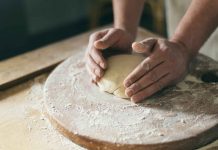The eye-catching aroma of freshly baked bread can’t be passed. For millennia, the recipes for this basic foodstuff have unfold across the globe, gracing tables from the crisp baguettes of
France to the gentle naan of India. But what’s in the loaves we purchase today?
In a generation of mass production and extended shelf lives, bread is much more likely to incorporate additives and preservatives than in the past. By peering past the label, we are able to higher understand what bread is and can be, as well as the element it performs in our lives.
The Building Blocks: Flour, Water, Yeast, and Salt
At its core, bread is easy. From flour, water, yeast, and salt come loaves, thanks to the alchemical magic of fermentation and baking. But industrial bread is some other matter.
Buy a loaf at the store, and the ingredient list is long—with some things you know and some you don’t, like the “dough conditioners” that help maintain a consistent texture.
Part of why they are used is that bread is an omnipresent affordable staple here in the U.S., but the reason it can (and does) consistently look and taste the same from loaf to loaf (and day to day) is that the bread makers don’t leave anything up to chance.
The result: bread that’s like a muffin as far as structure goes If you watched what nutritionists say about junk food is awful, wait until you see the list of additives in a trendy commercially produced loaf of bread.
Preservatives: Keeping Bread Fresh
One ingredient in the bread is calcium propionate. It is a meals additive that acts as a mild preservative to save you mould from forming and facilitates to hold the bread clean for a longer time.
Calcium Propionate Safety
Calcium propionate is on the list of substances FDAs do consider safe. That’s the good news. Now the bad news: Some studies have shown possible links between calcium propionate safety and problems in children, like irritability or hyperactivity. The studies that have claimed to show a connection often have some serious flaws. And the problems that the studies claim to find often don’t find their way into other studies.
Acidity Regulators: Balancing Flavor and Preservation
Another issue you can run throughout is lactic acid. This might sound peculiar in the context of bread, however it’s miles a common and herbal substance.
Lactic Acid in Food
Produced thru fermentation, lactic acid in food in meals is something you can discover in lots of extraordinary meals, from yogurt to sourdough bread. In industrial baking, it is frequently brought as an acidity regulator to enhance flavor and help with renovation. The belongings you eat is appeared as safe and is useful in that it has probiotics. (Lactic acid in your gut leads to the formation of more lactic acid, and that is right for your gut!) And the problems that the studies claim to find often
don’t find their way into other studies.







